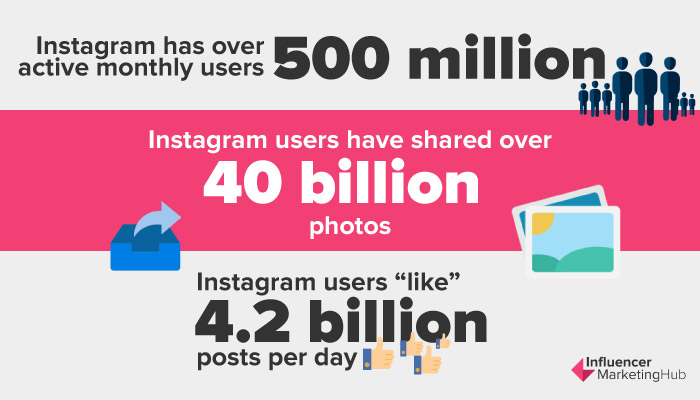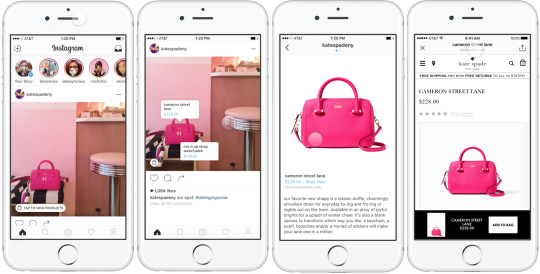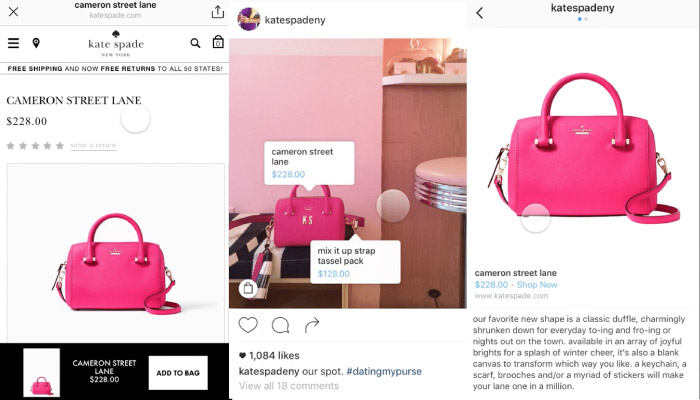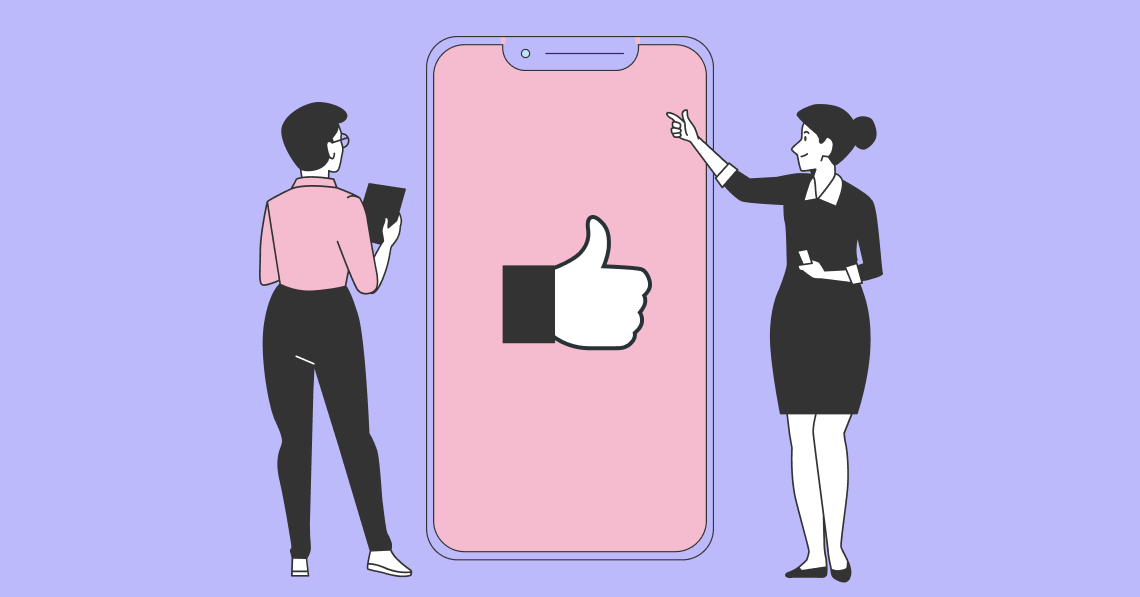本月,Instagram推出一个新的有限元分析ture that is sure to be a game changer in the near and distant future. Instagram Shoppable photos are the next natural step in Instagram’s progression toward being a more business-friendly social platform. Withmore than half a billionmonthly active users andover half a million advertisers, it was only a matter of time before users could start buying products right from the app.
Instagram购物 - 有关购物帖子的五件事:
- #1 Instagram Shoppable Photo Tags are a reality for a tiny portion of the brands on Instagram
- #2 Instagram Shoppable Posts are only available on iOS, and only within the US
- #3您的Instagram提要不会成为垃圾邮件中心
- #4 Product tags can only be implemented by Instagram internally
- #5 Instagram isn’t making any money off this...yet
Essentially, shoppable photos allow companies to tag their posts with products, much like you or I would tag our friends. Tap on the tags, and you’re taken to a full product description with a “Buy Now” button, all within the IG app itself. Tap that button if you want to purchase and you’ll be taken to the company’s website to purchase; if you don’t want to buy, it’s a single tap back to your feed because you haven’t left the app. It all works exactly like Instagram does now, so there’s no learning curve for users. There are no fees on either side—the buyer pays what the seller is charging, and the seller pays nothing to Instagram for any sale.
But don’t start taking pictures of your old stuff to sell on Instagram just yet. The same goes for those of you who think this might preclude the need to involve influencers in your marketing. Here are some key things to know about the latest addition to the world of e-commerce.
#1 Instagram Shoppable Photo Tags are a reality for a tiny portion of the brands on Instagram
The company wants to take things slowly, and rightly so. Withover 95 million posts and 4.2billionlikes every day, the potential for a tiny glitch to become catastrophic is very real. So, for now, IG has invited only 20 brands to participate in the rollout, all of them in the fashion space—a natural fit for an app built on visual appeal. Companies like JackThreads, Abercrombie & Fitch, Kate Spade, and Hollister—all of which have popular feeds with quality content—are part of this first phase.

#2 Instagram Shoppable Posts are only available on iOS, and only within the US
These limitations will likely be the first to go away as the reliability and stability of shoppable photos is put to the test over the next few months. As popular as the iPhone is, iOS only accounts forless than 12% of the smartphone market share, while Android sits at 87%. Meanwhile,80% of Instagram’s users在国家 /地区分享和喜欢的照片notthe United States. That’s a lot of users whose money won’t be spent on Instagram, and you can bet that the brands are going to want to see how this all scales. If Instagram's Shopping Tags can’t handle that kind of traffic without tweaks and updates, it’s better for Instagram to learn that with only 20 angry companies.
#3您的Instagram提要不会成为垃圾邮件中心
The implementation of shoppable photos won’t visually intrude with your feed. If a photo contains product tags, the only indicator will be a small white button in the lower left hand corner that states “View Products.” Tapping that button reveals the tags, each of which can be clicked on to view more information and the link to buy the product. It seems as though Instagram is trying to do this in a way that doesn’t cheapen their own product for the benefit of its advertisers.
#4 Product tags can only be implemented by Instagram internally
They haven’t yet developed an interface for brands to do this on their own; for now, the 20 companies who have access to this feature must coordinate with the Instagram team to add the tags to their posts. It’s doubtful the reason for this is that IG hasn’t been able to figure out how to let companies do it themselves. More likely, they are leaving themselves a little wiggle room to make editorial decisions on how companies choose to use the feature. As engineers of social software, the Instagram team is focused on making shoppable photos a functional and easy-to-use end-user experience. By drip-feeding the feature into their ecosystem, IG will get a handle on how marketers envision using the technology—and will be able to ensure that brand visions aren’t intrusive to the user experience.
#5 Instagram isn’t making any money off this...yet
As stated before, Instagram isn’t taking any cut of the profits on items sold through the shoppable posts feature, or adding any kind of fees that would end up coming out of users’ wallets. For now, the focus is on getting it right, both for users and companies. As the kinks are worked out, and more companies are invited to participate, the plan is to allow them to pay for promotingshoppable photosout to the feeds of users who aren’t already following them. You don’t need to be a marketing specialist to realise the economic potential of this for brands and Instagram alike. That Instagram is a popular service round the world is already known: reach just 5% of monthly active users and that’s an audience of 25 million. But consider this statistic, reported atLocowise:75%的Instagram用户对他们已经看到的赞助帖子采取行动,单击嵌入式链接以从应用程序中删除并转到网站。这样的数字就是为什么Instagram和公司都对平台的未来感到非常兴奋的原因。
What is not yet known about the future of shoppable photos is where Instagram will ultimately draw the line on participation. Today, it’s just those 20 companies that are in on the action. The plan, of course, is to roll it out to more companies over time. But will it only be business accounts? What about influencers? There have been a few questions swirling around about where they sit in all this. One only has to think of some of the more notorious influencer failsto see how something like this could get out of hand —think of斯科特·迪克(Scott Disick)或者Naomi Campbell’shasty copy/paste jobs in their paid posts for BooTea and Adidas, respectively. Those incidents expose the blurred line between social posts and cynical cash-outs, and are cited as a reason why influencers probably won’t be able to make their posts shoppable. If that’s the case, others have said, this might be the end of influencer marketing itself: why throw money and resources at influencers if they aren’t able to help you sell your stuff?
如果这两个问题都不错过正确的影响力营销的重点,那么这两个问题都是有效的。金博宝188备用网址首先,斯科特·迪克(Scott Disick)和内奥米·坎贝尔(Naomi Campbell)事件不应被视为影响者营销。金博宝188备用网址这些都是直接的老式报酬名人代言。如果有的话,可购物的帖子代表了有影响力的营销迈出的一大步。金博宝188备用网址想一想:迪克斯(Disick)每个帖子收费$ 15,000- $ 20,000,而Bootea基本上看到金钱因他的失误而流失。一旦Instagram使您可以为购物帖子付费以出现在其用户的供稿中,就无需经过一个中间人来吸引他的追随者 - 只是将可购物的照片定位给关注他并希望获得最好的人。当然,如果没有可识别的面孔,则有针对性的广告可能没有那么有效。
这就揭示了为什么influen的cer marketing will remain important. The real aim of influencer marketing is to build trust, awareness, and community with an influencer’s legion of followers; that doesn’t happen without the aid of an influencer. But once you supplement a solid influencer campaign with a paid shoppable post, all the pieces come together. The followers a brand does pick up will see the posts organically, while those who don’t end up following the company will at least have a level of familiarity and comfort with them when the paid post shows up in their feed. It’s a perfect one-two punch that’s going to bring influencer marketing to an even higher level of importance. With a paid endorsement, a company might get a one-time rush of purchases. But marketers have said that influencer marketing has already established itself as a way tobuild a better customer. We’ve already seen how effective a thoughtful influencer campaign can be in ingratiating a brand to the public and earn some serious social capital. With InstagramShoppable Photo Tags, companies now get to turn that social capital into real money—and that’s why we’re saying this will be a real game changer.





